How Finalyse can help
Designed to incorporate climate-related and environmental risk considerations into your risk management, governance, ICAAP and disclosures
Designed to meet ECB requirements asking banks to perform comprehensive, sound, and forward-looking physical risk assessments.
Climbing the Regulatory Everest: A Comprehensive Guide for Banks in Addressing Climate and Environmental Risks as per ECB Guidelines

Meghna Jain is a senior consultant based in Finalyse Brussels with expertise in identification and assessment of environmental and climate-related risks across portfolios and integrating climate-related risks within the overall risk systems of the financial institution. She has extensive experience with a large European Banks in building scenarios, developing and carrying C&E risk assessments, setting risk appetites, modelling transition risk and physical risks for banks and ESG/climate reporting.
In today’s world, where climate change poses unprecedented risks to the financial sector, regulatory bodies are stepping up efforts to ensure that institutions are well-prepared to tackle the challenges ahead. The European Central Bank (ECB) Guidelines released in 2020 stand as a pivotal framework, guiding banks in the effective management of climate-related risks. The Guidelines outline a comprehensive approach to Business Models & Strategy, Governance and Risk Appetite, Risk Management, and Disclosure, covering aspects from risk assessment to integration within the existing risk management processes.
Embarking on the journey towards compliance with these guidelines as regards Climate-related and Environmental Risks (C&E Risk) is paramount for financial institutions to safeguard their operations, protect their reputations, and foster trust among their stakeholders. However, navigating these guidelines and implementing them effectively can be a challenge for many institutions.
Key Challenges faced by Banks to implement ECB Guidelines
Interpreting the ECB Guidelines
The ECB’s guidelines include a comprehensive framework addressing areas from risk assessments to reporting mechanisms, necessitating a profound comprehension. Banking institutions must remain vigilant and aligned with these established standards. However, various institutions encounter challenges in interpreting and harmonizing their existing practices with these detailed and complex guidelines.
Time and Resources Constraints
Effectively implementing the ECB’s guidelines often demands a reallocation of resources. This may entail investing in new technologies, hiring specialized staff, and conducting comprehensive training programs. Balancing regulatory compliance with cost-effectiveness proves challenging, especially for smaller institutions. Tight compliance timelines further compound the challenge, with banks struggling to implement changes within the stipulated timeframes, particularly amidst concurrent regulatory demands and market pressures.
Governance Structure and Stakeholder Communication
Establishing a governance structure involves defining roles, responsibilities and policies while effectively communicating climate-related risks and mitigation strategies to stakeholders. Achieving the recommended level of transparency in disclosures is a challenge for banks as they strive to strike a balance between protecting their reputation and complying with regulations.
Climate Risk Modelling and Assessment Integration
Creating accurate models for climate risk assessment requires specialized expertise. However, many banks struggle with this due to a lack of necessary skills, impacting the strength of their risk management strategies. Moreover, incorporating climate risk management into existing processes is a challenge necessitating substantial adjustments in workflows and systems.
Data Quality and Availability
The guidelines necessitate robust data for effective risk assessment and reporting. Many banks struggle with the quality and availability of relevant data. Obtaining accurate climate-related data for forward-looking scenarios can be a formidable challenge.
As the financial industry grapples with the evolving challenges stemming from climate change, the implementation of the ECB’s guidelines emerges as a crucial step.
Recognizing and addressing these challenges head-on is imperative for banks to navigate the complex terrain of regulatory compliance. While each obstacle presents its own set of complexities, it is through strategic planning, collaboration, and leveraging expert guidance that banks can overcome these challenges and fortify their position in the face of climate-related risks.
Below is a comprehensive guide that provides a structured roadmap to assist banking institutions in implementing the ECB’s Guidelines, fostering resilience and sustainability.
ROADMAP
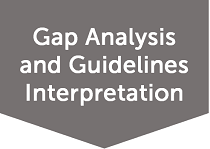
To assess a bank’s current compliance status, a comprehensive gap analysis is important. This initial step is instrumental in establishing a robust foundation for the subsequent processes. The comprehensive evaluation entails a review of the bank's operational landscape, policies, procedures and internal controls to identify any misalignments between the bank’s current practices and the requirements outlined by the ECB’s guidelines. This process serves as a cornerstone for prioritizing assessment efforts and approaching them accordingly.
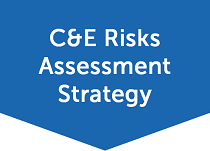
Relevant Stakeholders and functions are identified and engaged to understand the key groups, company's functions, business model, business strategy and operations to inform the assessment strategy and process roadmap.
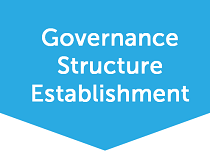
Setting-up a governance structure including sustainability and climate experts within the management body is an essential step to ensure effective monitoring. This step involves setting up policies and procedures for clear allocation of roles and responsibilities for C&E risks. Effective oversight is also critical to shape the bank’s business strategy in the short, medium and long term, based on the identification and assessment of climate risks.

To identify, assess, integrate and effectively oversee the climate-related risks within the bank’s existing risk culture, an adequate representation of the present knowledge in climate and environmental risks is required. Dedicated training and courses for the staff can be helpful for the effective implementation of new policies and procedures.
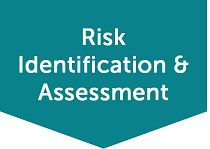
The identification and assessment of material and vulnerable exposures encompass both physical and transition risks across portfolios and risk types, including market risk, credit risk, liquidity risk, operational risk, and business risk.The materiality identification and assessment need a mix of qualitative and quantitative information. This step will involve leveraging the existing frameworks within the bank and the frameworks and data sources built within Finalyse, such as the ESG Score Metrics, the physical risk prototype, the inclusion of transition risk into the credit risk models by adjusting PDs for climate risks, or the stress testing and scenario analysis framework.
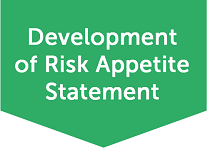
The qualitative and quantitative set up of risk appetite that feeds into the Risk Appetite statement based on the risk assessment ensures a long-term compliance and oversight.

After developing a holistic approach to data governance for climate risks, internal reporting to disclose governance, quantitative climate and ESG metrics, vulnerable exposures and regulatory reports such as TCFD, CSRD, etc. should be developed.
Gap Analysis
Conducting a comprehensive gap analysis enables institutions to obtain a clear understanding of their current compliance status, prioritize remediation efforts, and develop a tailored roadmap for achieving full compliance. The gap analysis should encompass the following:
- Review of existing policies, procedures, and internal controls: Existing policies should be reviewed, and new policies should be drawn up to define the bank’s strategy and goals for reducing its carbon footprint and promoting sustainable development. This step involves identifying areas where existing governance frameworks may not align with the expectations outlined in the ECB’s guidelines.
- Assessment of compliance risks: Evaluate the potential financial, reputational, and operational risks associated with non-compliance.
Climate-related and Environmental Risks Assessment Strategy
- Stakeholder Engagement: Internal stakeholders are identified to gain insight into the bank's business, operations, and strategic objectives in the short, medium, and long term.
- Establishing Clear Objectives and Targets: Define specific and measurable goals for achieving full compliance with the ECB’s guidelines.
- Developing a Detailed Action Plan: Outline the specific steps, timelines, and responsibilities for implementing each element of the compliance programme.
Establishing the Governance Structure

The Board should ensure appropriate representation of subject matter experts.
Training existing staff and recruiting new subject matter experts.
Define clear roles and responsibilities through the creation of climate policy.
Integrating roles and responsibilities pertaining to the C&E risks within the three lines of defense model.
Establishment of sustainability and climate-related risk committees to facilitate effective oversight and escalation of heightened ESG risks.
Establishment of transition risk framework set-up for the onboarding process of new clients.
Development of sector-level policies tailored to industries with elevated environmental risks, such as Oil and Gas, Mining, Power Generation, etc. These policies will define restrictions pertaining to exposure and transactions within these sectors.
Risk Identification and Assessment
The risk identification and assessment of climate-related risks are conducted by leveraging existing risk frameworks within the bank or utilizing those available in the market, while also developing new ones as necessary. This approach allows for a focused analysis of the financial exposures for physical and transition risks across different risk categories. Climate-related and environmental risks are significant drivers of risk, with effects manifesting through various risk types. For example, a sudden ban on coal-fired power stations may push a coal company into default or a sudden carbon tax can lead to the repricing of assets, impacting the price of bonds.
The assessment should encompass the following aspects:
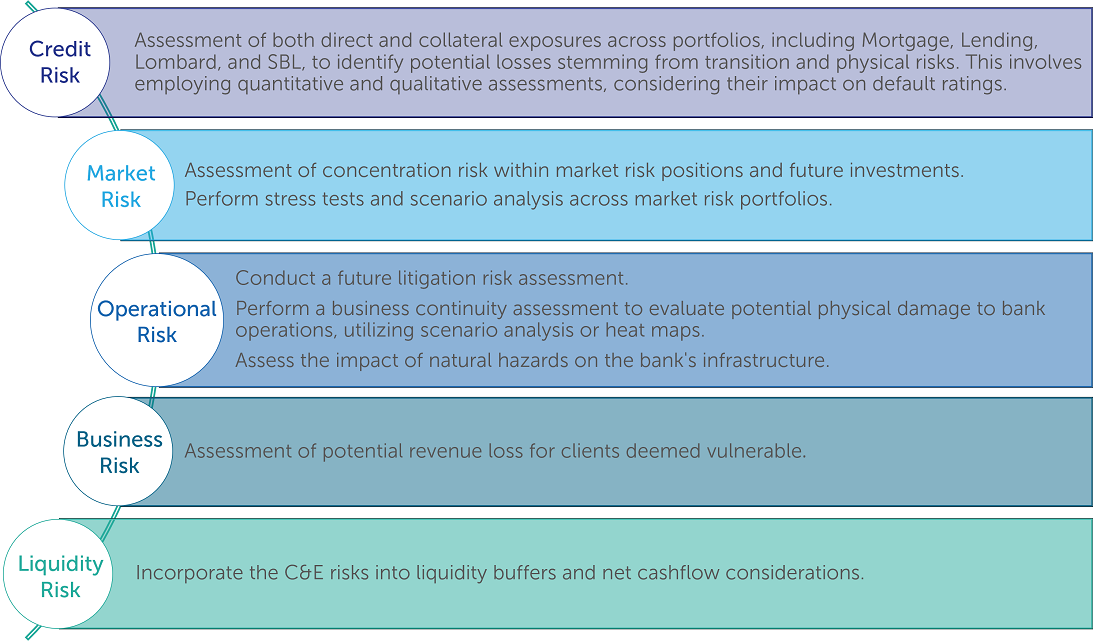
The aforementioned assessment approach can be achieved through a combination of qualitative and quantitative methodologies and frameworks, including:
- Scenario Analysis and Stress Testing across portfolios and asset classes: Utilizing scenarios outlined by the Network for Greening the Financial System (NGFS) as a benchmark, scenarios can be constructed within the banking industry.
- Physical Risk Model: Employing a quantitative model to produce heat maps and estimate potential losses for hazard risks such as floods, typhoons, tsunamis, wildfires, etc., across Mortgage and Lending portfolios.
- Integration of Transition Risk into PD Models: Incorporating transition risk into Probability of Default (PD) models to evaluate their impact on default ratings for each company within the bank's portfolio.
- ESG Scorecard: Development of a scorecard to assess Environmental, Social, and Governance (ESG) scores across counterparties, aiding in the identification of ESG performance.
- Concentration Risk Assessment: Creation of quantitative metrics to evaluate concentration risk across vulnerable geographies, sectors, and industries within the portfolio, facilitating the identification of the most vulnerable exposures.
Climate Risk Monitoring
Continuous monitoring and evaluation serve as the cornerstones for upholding the ECB’s guidelines compliance, ensuring the bank's compliance program remains resilient and responsive to evolving regulations and emerging risks. This ongoing process should encompass regular audits, assessments, quantitative thresholds, and metrics, highlighting vulnerable exposure to climate risk in management reports for regular oversight.
Risk Appetite Statement (RAS) Formation
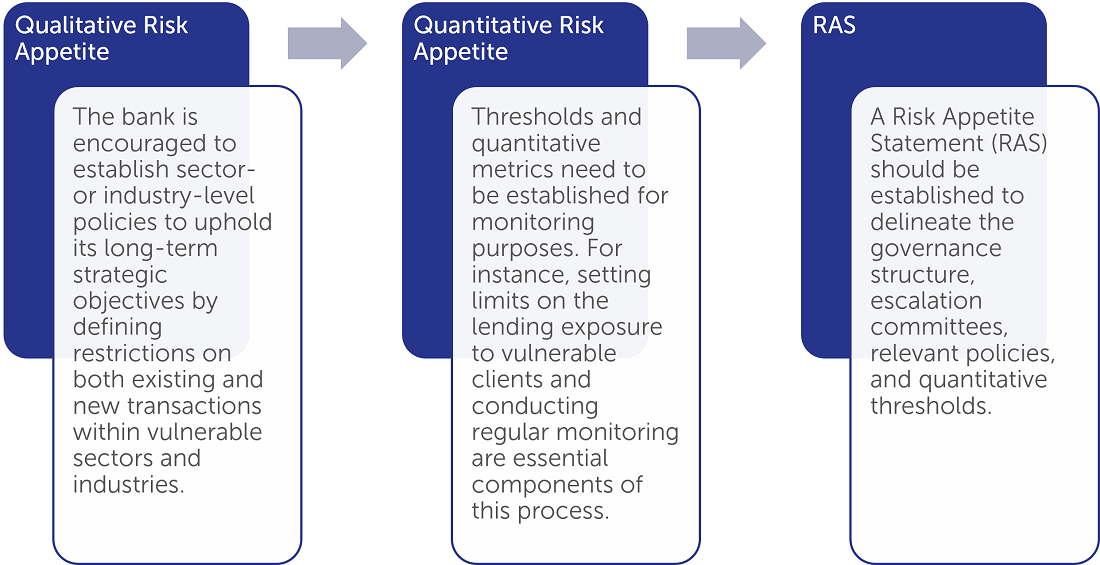
Quantitative Risk Metrics
The implementation of quantitative climate risk metrics is pivotal for identifying and assessing exposure levels across material and vulnerable clients, sectors, and industries susceptible to transition or physical risks. By categorizing risks according to accepted parameters, these metrics provide a structured approach to understanding climate-related vulnerabilities. Furthermore, integrating these metrics into management meetings ensures continuous monitoring and enables informed strategic decision-making. An illustrative example of such a metric is provided below:
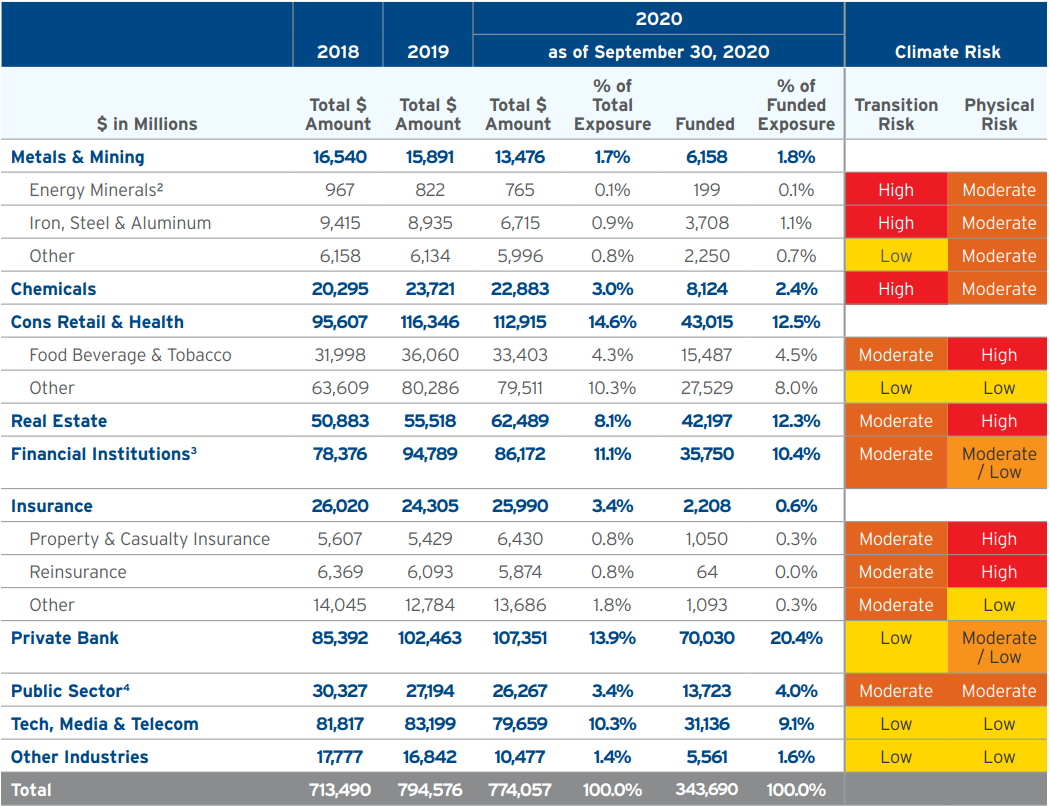
Source: TCFD “Proposed Guidance on climate related metrics, targets and transition plans in June 2021
Disclosures
Financial disclosures related to climate are essential as they serve to enhance transparency by providing stakeholders with clear and comprehensive insights into an organization's operational landscape, financial performance, risks, and governance practices concerning climate and environment. This transparency enables informed decision-making among investors, customers, regulators, and the public, allowing them to assess the organization's financial health, sustainability practices, and adherence to regulatory requirements. Furthermore, such disclosures play a vital role in risk management as they aid in identifying and mitigating potential risks, enhance accountability and governance by holding organizations accountable to stakeholders, and cultivate investor confidence by demonstrating a commitment to ethical and responsible business conduct. To embark on the path toward fulfilling disclosure requirements, organizations are encouraged to incorporate the following aspects in their disclosures:
- Align with the ECB’s Expectations: Ensure that your climate risk disclosures are in line with the ECB's Guide on climate-related and environmental risks and other relevant regulations.
- Utilize Standardized Metrics: Consider incorporating standardized metrics such as the Task Force on Climate-Related Financial Disclosures (TCFD) framework or the Corporate Sustainability Reporting Directive (CSRD) for transparent reporting. For Instance, the TCFD recommended disclosures for all sectors are as follows:
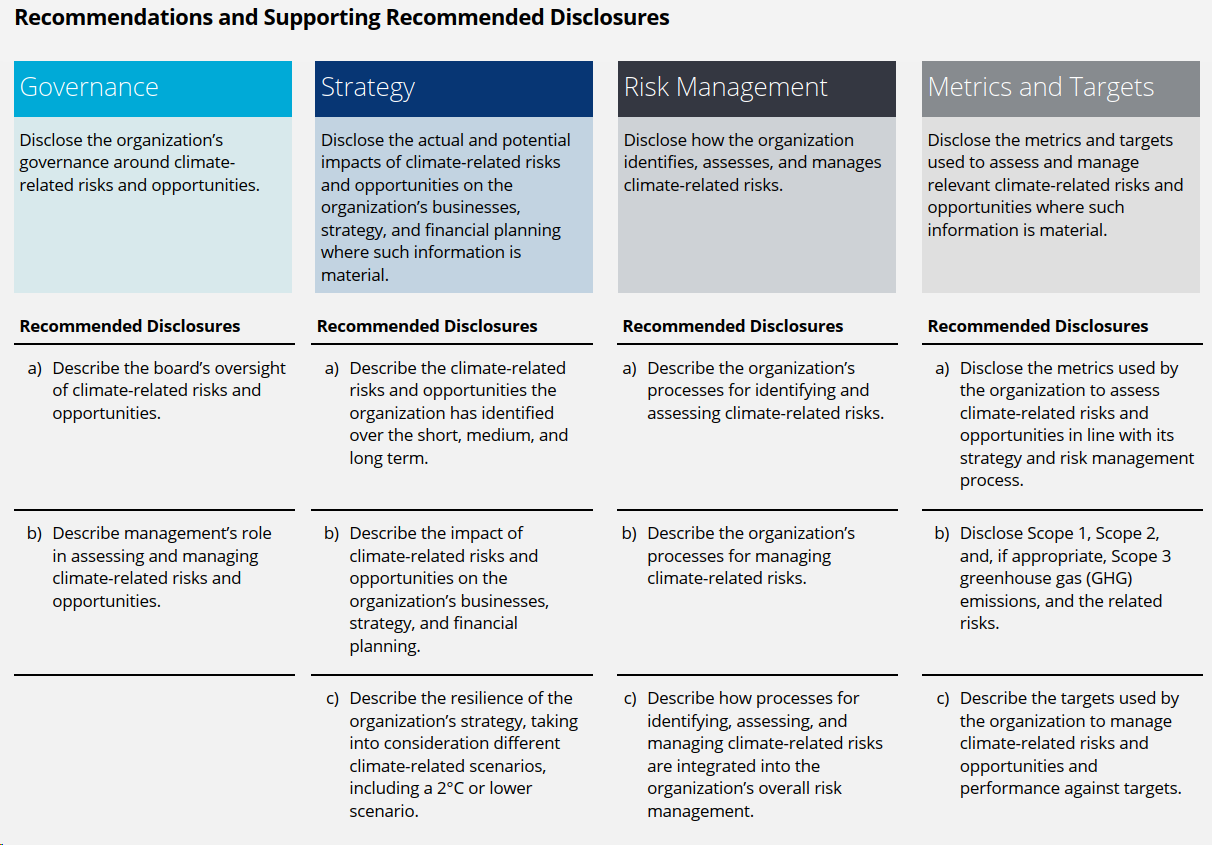
Source: TCFD “Recommendations of the Task Force on Climate Related Financial Disclosures”, June 2017
- Effective Communication: Communicate your climate risk management approach and performance effectively to stakeholders, including investors, regulators, and the public. This would enable stakeholders to better understand the concentrations of carbon-related assets in the financial sector and the financial system’s exposures to climate-related risks, foster an early assessment of climate-related risks and facilitate market discipline.
Conclusion
Achieving full compliance with the ECB’s guidelines is essential for long-term success. This comprehensive roadmap can assist banks in navigating the intricate landscape of the ECB’s guidelines on climate-related and environmental risk, enabling them to establish a robust compliance programme that safeguards their operations and protects their reputation.
How can Finalyse help?
- ESG Reporting (TCFD, CSRD, Sustainability Report)
- Risk Appetite Framework
- Establishing Risk Identification and Assessment Framework
- Establishing Governance Structure, Policies and Procedures
- Workshops
- Transition Risk and Physical Risk Assessment
- End to End Support and Guidance
- ECB Compliance
Finalyse InsuranceFinalyse offers specialized consulting for insurance and pension sectors, focusing on risk management, actuarial modeling, and regulatory compliance. Their services include Solvency II support, IFRS 17 implementation, and climate risk assessments, ensuring robust frameworks and regulatory alignment for institutions. |

Our Insurance Services
Check out Finalyse Insurance services list that could help your business.
Our Insurance Leaders
Get to know the people behind our services, feel free to ask them any questions.
Client Cases
Read Finalyse client cases regarding our insurance service offer.
Insurance blog articles
Read Finalyse blog articles regarding our insurance service offer.
Trending Services
BMA Regulations
Designed to meet regulatory and strategic requirements of the Actuarial and Risk department
Solvency II
Designed to meet regulatory and strategic requirements of the Actuarial and Risk department.
Outsourced Function Services
Designed to provide cost-efficient and independent assurance to insurance and reinsurance undertakings
Finalyse BankingFinalyse leverages 35+ years of banking expertise to guide you through regulatory challenges with tailored risk solutions. |

Trending Services
AI Fairness Assessment
Designed to help your Risk Management (Validation/AI Team) department in complying with EU AI Act regulatory requirements
CRR3 Validation Toolkit
A tool for banks to validate the implementation of RWA calculations and be better prepared for CRR3 in 2025
FRTB
In 2025, FRTB will become the European norm for Pillar I market risk. Enhanced reporting requirements will also kick in at the start of the year. Are you on track?
Finalyse ValuationValuing complex products is both costly and demanding, requiring quality data, advanced models, and expert support. Finalyse Valuation Services are tailored to client needs, ensuring transparency and ongoing collaboration. Our experts analyse and reconcile counterparty prices to explain and document any differences. |

Trending Services
Independent valuation of OTC and structured products
Helping clients to reconcile price disputes
Value at Risk (VaR) Calculation Service
Save time reviewing the reports instead of producing them yourself
EMIR and SFTR Reporting Services
Helping institutions to cope with reporting-related requirements
Finalyse PublicationsDiscover Finalyse writings, written for you by our experienced consultants, read whitepapers, our RegBrief and blog articles to stay ahead of the trends in the Banking, Insurance and Managed Services world |

Blog
Finalyse’s take on risk-mitigation techniques and the regulatory requirements that they address
Regulatory Brief
A regularly updated catalogue of key financial policy changes, focusing on risk management, reporting, governance, accounting, and trading
Materials
Read Finalyse whitepapers and research materials on trending subjects
Latest Blog Articles
Contents of a Recovery Plan: What European Insurers Can Learn From the Irish Experience (Part 2 of 2)
Contents of a Recovery Plan: What European Insurers Can Learn From the Irish Experience (Part 1 of 2)
Rethinking 'Risk-Free': Managing the Hidden Risks in Long- and Short-Term Insurance Liabilities
About FinalyseOur aim is to support our clients incorporating changes and innovations in valuation, risk and compliance. We share the ambition to contribute to a sustainable and resilient financial system. Facing these extraordinary challenges is what drives us every day. |

Finalyse CareersUnlock your potential with Finalyse: as risk management pioneers with over 35 years of experience, we provide advisory services and empower clients in making informed decisions. Our mission is to support them in adapting to changes and innovations, contributing to a sustainable and resilient financial system. |

Our Team
Get to know our diverse and multicultural teams, committed to bring new ideas
Why Finalyse
We combine growing fintech expertise, ownership, and a passion for tailored solutions to make a real impact
Career Path
Discover our three business lines and the expert teams delivering smart, reliable support


